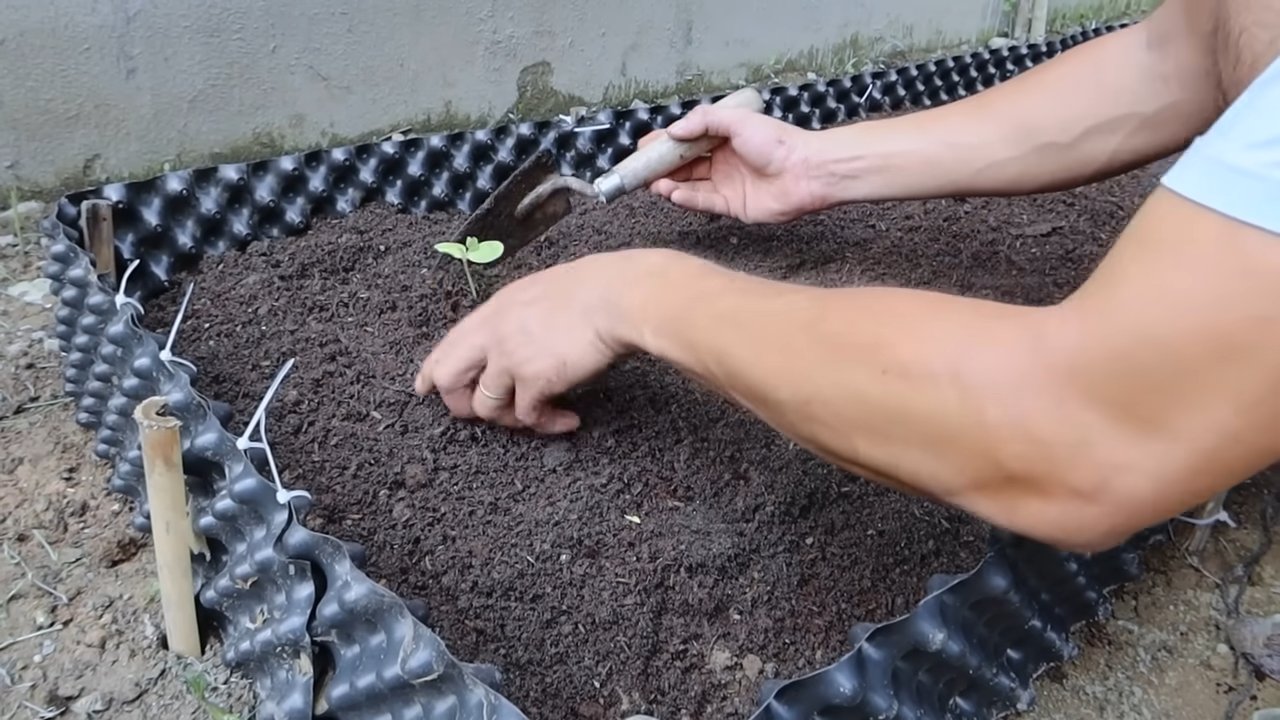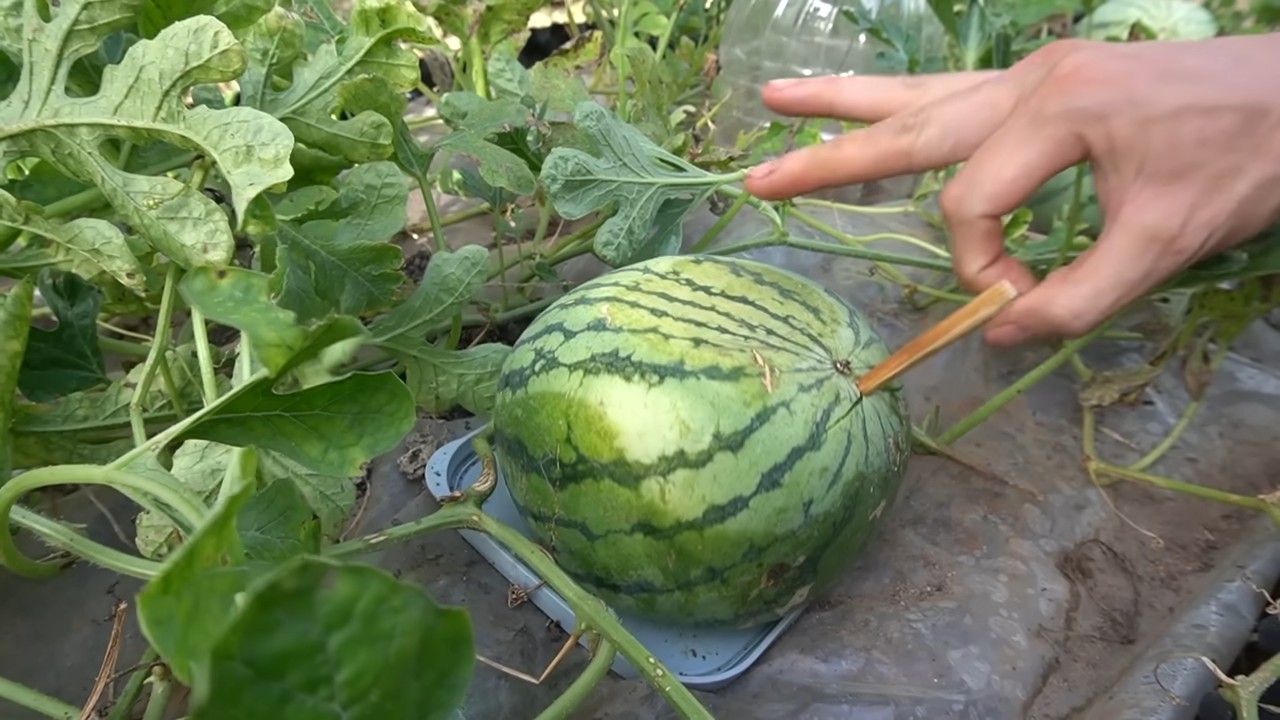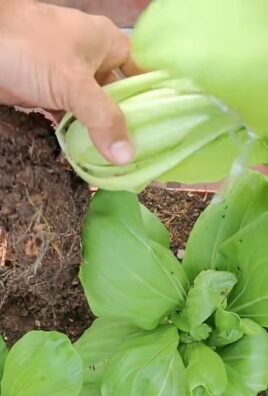Grow Square Watermelons: Ever dreamt of wowing your friends and family with a truly unique and conversation-starting fruit? Imagine slicing into a perfectly cubed watermelon – a feat that seems straight out of a futuristic farm! Well, the good news is, you don’t need a time machine or a degree in agricultural engineering to achieve this. This DIY guide will unlock the secrets to growing these geometrically pleasing melons right in your own backyard.
The practice of shaping fruits and vegetables isn’t new. In Japan, farmers have been cultivating square watermelons for decades, initially as a space-saving solution for smaller refrigerators. Over time, they’ve become a symbol of innovation and a sought-after novelty item. But beyond the novelty, growing square watermelons is a fun and rewarding project that connects you to the ingenuity of farming practices.
Why should you try this DIY trick? Because it’s a fantastic way to engage with your garden on a whole new level! It’s a conversation starter, a unique gift, and a testament to your gardening prowess. Plus, it’s a great project to do with kids, teaching them about plant growth and the fascinating ways we can interact with nature. I’m excited to show you how to grow square watermelons with just a few simple tools and techniques. Let’s get started!

Growing Square Watermelons: A Fun and Fruity DIY Project!
Hey there, fellow gardening enthusiasts! Ever seen those perfectly square watermelons and wondered how they’re grown? Well, wonder no more! I’m going to walk you through the surprisingly simple process of growing your own geometrically pleasing watermelons. It’s a fun project that’s sure to impress your friends and family, and it’s a great conversation starter at your next summer barbecue.
What You’ll Need
Before we dive in, let’s gather our supplies. This project requires a little more than just seeds and soil, but don’t worry, it’s all readily available.
* **Watermelon Seeds:** Choose a variety that produces relatively small to medium-sized watermelons. Smaller varieties are easier to manage within the molds. I recommend Sugar Baby or Golden Midget.
* **Seed Starting Supplies (Optional):** If you want a head start, you’ll need seed starting trays, seed starting mix, and a heat mat (optional).
* **Potting Soil:** A good quality potting mix is essential for healthy watermelon growth.
* **Large Pots or Garden Bed:** You’ll need a space to transplant your seedlings or directly sow your seeds. Watermelons need plenty of room to sprawl.
* **Square Molds:** This is the key to the whole operation! You can find these online, often marketed as “watermelon shaping molds” or “fruit shaping molds.” Make sure they’re appropriately sized for the watermelon variety you’ve chosen. Look for molds with drainage holes and ventilation.
* **Fertilizer:** A balanced fertilizer, followed by a fertilizer higher in phosphorus and potassium, will help your watermelons thrive.
* **Watering Can or Hose:** Essential for keeping your plants hydrated.
* **Gloves:** To protect your hands while working in the garden.
* **Pruning Shears:** For trimming vines and removing unwanted fruit.
* **Patience:** This project takes time and a little bit of luck!
Getting Started: Planting Your Watermelon Seeds
Whether you choose to start your seeds indoors or directly sow them in your garden, the initial planting process is the same.
1. **Starting Seeds Indoors (Optional):** About 4-6 weeks before the last expected frost, fill your seed starting trays with seed starting mix. Sow 2-3 seeds per cell, about ½ inch deep. Water gently and keep the soil consistently moist. Place the trays on a heat mat (if using) and keep them in a warm, sunny location. Once the seedlings emerge, thin them to one plant per cell.
2. **Direct Sowing:** Once the soil has warmed up to at least 70°F (21°C), you can directly sow your watermelon seeds in your garden bed or large pots. Plant the seeds about ½ inch deep and space them according to the variety’s recommendations (usually 2-3 feet apart).
3. **Watering:** Water the seeds or seedlings thoroughly after planting. Keep the soil consistently moist, but not waterlogged.
4. **Sunlight:** Watermelons need at least 6-8 hours of direct sunlight per day. Choose a sunny location for your plants.
5. **Fertilizing:** Once the seedlings have developed a few sets of true leaves, begin fertilizing them with a balanced fertilizer, following the package instructions.
The Crucial Step: Introducing the Molds
This is where the magic happens! Timing is everything when it comes to placing the molds.
1. **Monitoring Fruit Development:** Keep a close eye on your watermelon plants. Once a small watermelon fruit (about 4-6 inches in diameter, depending on the size of your mold) starts to develop, it’s time to introduce the mold. This is usually about 2-3 weeks after the flower has been pollinated.
2. **Selecting the Right Fruit:** Choose a healthy, unblemished watermelon fruit that is roughly the size of the mold’s interior. Avoid fruits that are misshapen or have any signs of damage.
3. **Carefully Placing the Mold:** Gently place the mold around the chosen watermelon fruit. Make sure the fruit is centered within the mold. Some molds come in two halves that you need to assemble around the fruit. If so, carefully align the halves and secure them tightly.
4. **Securing the Mold:** Most molds have screws or clips to hold the two halves together. Tighten these securely, but be careful not to damage the watermelon fruit.
5. **Supporting the Mold:** As the watermelon grows, it will become heavier. You may need to provide additional support to the mold to prevent it from falling or damaging the vine. You can use stakes or ties to secure the mold to a nearby support.
6. **Ventilation and Drainage:** Ensure that the mold has adequate ventilation and drainage. This will help prevent the watermelon from rotting or developing mold inside the mold.
Nurturing Your Square Watermelon
Once the mold is in place, it’s important to continue providing proper care to your watermelon plant.
1. **Watering:** Water your watermelon plant regularly, especially during hot, dry weather. Water deeply and consistently, but avoid overwatering.
2. **Fertilizing:** Continue fertilizing your watermelon plant with a fertilizer higher in phosphorus and potassium. This will help the watermelon fruit grow and ripen properly.
3. **Pruning:** Prune away any unwanted vines or leaves that are shading the watermelon fruit. This will help the fruit receive more sunlight and air circulation.
4. **Pest and Disease Control:** Monitor your watermelon plant for pests and diseases. Take appropriate measures to control any problems that arise.
5. **Patience is Key:** Resist the urge to open the mold prematurely! It takes time for the watermelon to fill out the mold and develop its square shape.
Harvesting Your Square Watermelon
The moment of truth! Knowing when to harvest is crucial.
1. **Determining Ripeness:** Determining when a watermelon is ripe can be tricky, even without a mold. Look for these signs:
* **The tendril closest to the fruit turns brown and dries up.**
* **The underside of the watermelon (where it rests on the ground) turns from white to a creamy yellow.**
* **The watermelon sounds hollow when you thump it.**
2. **Opening the Mold:** Once you believe the watermelon is ripe, carefully open the mold. Be prepared for a burst of watermelon goodness!
3. **Harvesting:** Gently remove the square watermelon from the vine.
4. **Enjoy!** Slice up your perfectly square watermelon and enjoy the fruits (literally!) of your labor.
Troubleshooting Tips
Even with the best planning, things can sometimes go wrong. Here are a few common issues and how to address them:
* **Watermelon Rotting Inside the Mold:** This is usually caused by poor ventilation or drainage. Make sure the mold has adequate ventilation holes and drainage holes. You can also try tilting the mold slightly to allow water to drain out.
* **Watermelon Not Filling the Mold:** This could be due to several factors, including poor pollination, insufficient nutrients, or the watermelon being too small when the mold was placed. Make sure your watermelon plants are properly pollinated, fertilized, and that you choose a watermelon fruit that is the right size for the mold.
* **Mold Breaking:** This can happen if the watermelon grows too large for the mold. Choose a mold that is appropriately sized for the watermelon variety you’ve chosen. You can also try reinforcing the mold with tape or straps.
* **Pests and Diseases:** Keep a close eye on your watermelon plants for pests and diseases. Take appropriate measures to control any problems that arise.
Choosing the Right Mold
Selecting the right mold is crucial for success. Here’s what to consider:
* **Size:** The mold should be appropriately sized for the watermelon variety you’ve chosen. Too small, and the watermelon won’t fit. Too large, and the watermelon won’t fill the mold properly.
* **Material:** Molds are typically made of plastic or metal. Plastic molds are generally less expensive, but metal molds are more durable.
* **Ventilation and Drainage:** The mold should have adequate ventilation and drainage holes to prevent the watermelon from rotting.
* **Ease of Use:** The mold should be easy to assemble and disassemble.
* **Durability:** Choose a mold that is made of durable materials and can withstand the weight of a growing watermelon.
Beyond Square: Exploring Other Shapes
While square watermelons are the most common, you can also find molds in other shapes, such as hearts, stars, and even pyramids! The process is the same, just with a different shaped mold. Experiment and have fun!
Important Considerations for Success
* Pollination is Key: Watermelons require pollination to set fruit. If you’re growing your watermelons indoors or in an area with limited pollinators, you may need to hand-pollinate the flowers.
* Soil Preparation: Watermelons prefer well-drained soil that is rich in organic matter. Amend your soil with compost or other organic materials before planting.
* Water Wisely:

Conclusion
So, there you have it! Growing square watermelons isn’t just a quirky gardening project; it’s a rewarding experience that combines ingenuity, patience, and a dash of agricultural artistry. We’ve walked you through the process, from selecting the right watermelon variety to carefully placing the mold and monitoring its progress. The result? A conversation-starting, space-saving, and undeniably cool fruit that’s sure to impress your friends and family.
But why should you try this? Beyond the novelty factor, growing square watermelons offers several practical advantages. Their unique shape makes them incredibly easy to stack and store, saving valuable refrigerator space. They’re also less likely to roll around and get bruised, extending their shelf life. Plus, the controlled environment within the mold can sometimes lead to a more uniform ripening and potentially even a sweeter flavor, although this can vary depending on the watermelon variety and growing conditions.
Don’t be afraid to experiment! While we’ve focused on the classic square shape, you can explore other mold designs. Heart-shaped watermelons, star-shaped melons, or even custom-designed molds are all possibilities. Just ensure the mold is food-safe, durable, and allows for adequate ventilation and drainage. You can also try different watermelon varieties. While smaller, round varieties are generally easier to mold, larger varieties can also be successful with the right mold size and support.
Consider these variations to elevate your square watermelon growing experience:
* Personalized Watermelons: Use molds with embossed designs or letters to create watermelons with personalized messages or logos. This is a fantastic idea for parties, gifts, or even small-scale commercial ventures.
* Colored Molds: Experiment with different colored molds. While clear molds allow you to monitor the watermelon’s growth, colored molds might influence the watermelon’s skin color in subtle ways. This is an area ripe for experimentation!
* Vertical Growing: Combine square watermelon growing with vertical gardening techniques. Train the watermelon vine to grow upwards along a trellis or support structure, further maximizing space efficiency.
* Grafted Watermelons: For even greater disease resistance and vigor, consider grafting your watermelon seedlings onto a more robust rootstock before placing them in the mold.
Ultimately, the key to success lies in careful observation, consistent watering, and a little bit of luck. Remember to monitor the watermelon’s growth closely, adjust the mold as needed, and protect it from pests and diseases.
We wholeheartedly encourage you to embark on this unique gardening adventure. Growing square watermelons is a testament to human creativity and our ability to shape the natural world. It’s a fun, educational, and ultimately delicious project that’s sure to bring a smile to your face.
So, grab your seeds, order your molds, and get ready to grow some square watermelons! And most importantly, don’t forget to share your experiences with us. We’d love to see your creations, hear about your challenges, and learn from your successes. Share your photos and stories on social media using #SquareWatermelonChallenge or leave a comment below. Let’s cultivate a community of square watermelon enthusiasts!
Frequently Asked Questions (FAQ)
What type of watermelon is best for growing in a square mold?
Smaller, round watermelon varieties tend to be the easiest to mold. Sugar Baby, Golden Midget, and Yellow Doll are popular choices. These varieties mature relatively quickly and fit comfortably within standard-sized molds. Larger varieties like Crimson Sweet can also be used, but you’ll need a larger mold and may need to provide additional support to the vine. Consider the size and shape of your mold when selecting your watermelon variety. Also, research the specific growing requirements of each variety to ensure optimal results.
Where can I buy square watermelon molds?
Square watermelon molds are readily available online from various retailers, including Amazon, Etsy, and specialty gardening supply stores. You can also find them at some local nurseries and garden centers. When purchasing a mold, ensure it’s made from food-safe plastic, is durable enough to withstand the weight of the growing watermelon, and has adequate ventilation and drainage holes. Read reviews from other gardeners to get an idea of the mold’s quality and performance.
How long does it take to grow a square watermelon?
The total time from planting the watermelon seeds to harvesting a square watermelon is roughly the same as growing a traditionally shaped watermelon – typically 75 to 90 days, depending on the variety and growing conditions. However, the time the watermelon spends inside the mold is crucial. You’ll typically place the mold around the watermelon when it’s about the size of a tennis ball and leave it in place for approximately 7 to 10 days, or until the watermelon fills the mold. Monitor the watermelon’s growth closely and adjust the mold as needed.
Will the square shape affect the taste of the watermelon?
The square shape itself doesn’t directly affect the taste of the watermelon. However, the controlled environment within the mold can potentially influence the ripening process and, consequently, the flavor. Some gardeners report that square watermelons tend to have a more uniform ripening and a slightly sweeter flavor, but this can vary depending on the watermelon variety, growing conditions, and the specific mold used. The most important factors affecting taste are still sunlight, water, and soil nutrients.
How do I know when the watermelon is ripe inside the mold?
Determining ripeness can be a bit tricky when the watermelon is inside the mold. Here are a few indicators to look for:
* The Tendril Test: The tendril closest to the watermelon stem should be brown and dry.
* The Ground Spot: The spot where the watermelon rests on the ground (or the bottom of the mold) should be a creamy yellow color.
* The Thump Test: Gently thump the watermelon. A ripe watermelon will have a deep, hollow sound. This takes practice, so compare the sound to other watermelons in your garden if possible.
* Visual Inspection: If possible, carefully peek inside the mold to observe the watermelon’s skin color. A ripe watermelon will have a dull, slightly waxy appearance.
If you’re unsure, it’s better to err on the side of caution and wait a few more days before harvesting.
Can I reuse the square watermelon mold?
Yes, square watermelon molds are reusable. After harvesting your square watermelon, thoroughly clean the mold with soap and water to remove any dirt, debris, or plant residue. Disinfect the mold with a diluted bleach solution (1 part bleach to 10 parts water) to prevent the spread of diseases. Rinse the mold thoroughly with clean water and allow it to air dry completely before storing it in a cool, dry place. Proper cleaning and storage will ensure that your mold lasts for many seasons.
What are some common problems I might encounter when growing square watermelons?
Some common problems include:
* Mold Fit Issues: The watermelon may grow too quickly or unevenly, causing it to become misshapen or crack the mold. Monitor the watermelon’s growth closely and adjust the mold as needed.
* Pest and Disease Problems: Watermelons are susceptible to various pests and diseases, such as aphids, squash bugs, and powdery mildew. Implement preventative measures, such as using insecticidal soap or fungicide, to protect your plants.
* Sunburn: If the watermelon is exposed to direct sunlight for extended periods, it may develop sunburn. Provide shade during the hottest part of the day.
* Rotting: If the mold doesn’t have adequate ventilation and drainage, the watermelon may rot. Ensure the mold is properly designed and that the soil is well-draining.
Is growing square watermelons worth the effort?
Absolutely! While it requires a bit more effort and attention than growing traditional watermelons, the novelty, space-saving benefits, and potential for a unique flavor make it a worthwhile project. It’s a fun and educational experience that’s sure to impress your friends and family. Plus, the satisfaction of harvesting a perfectly square watermelon is truly rewarding.




Leave a Comment